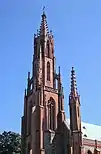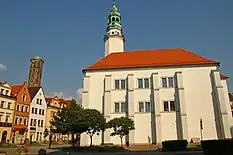Lubań
Lubań [ˈlubaɲ] (Czech: Lubáň; German: Lauban), sometimes called Lubań Śląski (English: Silesian Lubań);[2][3] is a town in the Lower Silesian Voivodeship in southwest Poland. It is the administrative seat of Lubań County and also of the smaller Gmina Lubań (although it is not part of the territory of the latter, as the town is a separate urban gmina in its own right).
Lubań | |
|---|---|
.jpg.webp) Old Town | |
 Flag  Coat of arms | |
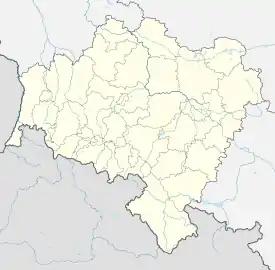 Lubań  Lubań | |
| Coordinates: 51°07′05″N 15°17′20″E | |
| Country | |
| Voivodeship | |
| County | Lubań County |
| Gmina | Lubań (urban gmina) |
| Government | |
| • Mayor | Arkadiusz Słowiński |
| Area | |
| • Total | 16.12 km2 (6.22 sq mi) |
| Population (2019-06-30[1]) | |
| • Total | 21,345 |
| • Density | 1,300/km2 (3,400/sq mi) |
| Time zone | UTC+1 (CET) |
| • Summer (DST) | UTC+2 (CEST) |
| Postal code | 59-800 |
| Area code(s) | +48 75 |
| Car plates | DLB |
| Website | http://www.luban.pl |
Lubań is a stop on the Polish sections of the Way of St. James pilgrimage route.
Geography
Situated north of the Jizera Mountains on the western shore of the Kwisa River, Lubań is part of the historic Upper Lusatia region. It is located about 25 km (16 mi) east of Zgorzelec/Görlitz and about 45 km (28 mi) northwest of Jelenia Góra. From 1975–1998 it was part of the former Jelenia Góra Voivodeship.
History
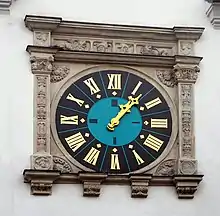
Lubań probably is at the site of a small settlement established by the West Slavic Milceni tribe in the 9th and 10th century, whose lands up to the Kwisa River from 927 on were gradually conquered by the German king Henry the Fowler and incorporated into the marca Geronis in 939. In 965 the ill-defined Milceni territory became part of the Imperial Margraviate of Meissen. From 1002 to 1031 the area was part of Poland. In 1156 Emperor Frederick Barbarossa vested his ally, the Přemyslid duke Vladislaus II of Bohemia with the territory around Bautzen (Budissin), then called "Milsko", and after the 15th century called "Upper Lusatia".
Like several other city foundings under the rule of the Přemyslid dynasty, owing to its favourable location on the historic Via Regia trade route close to the border with the Duchy of Silesia of fragmented Poland, Lubań expanded rapidly in the course of the German Ostsiedlung. In 1220 or 1268 (the second date is more probable) it is documented as a town with Magdeburg rights. Since about 1253 Upper Lusatia temporarily had been under the rule of the Ascanian margraves John I and Otto III of Brandenburg. By the end of the 13th century Luban's first brewery was founded by the Franciscans[4] and cloth production flourished thanks to Flemish settlers.[5] In 1297, a clothiers' uprising took place, which was brutally suppressed. Its two leaders were beheaded at the market square.[5]
In 1319 the town became part of the Duchy of Jawor of fragmented Poland under the Piast Duke Henry I of Jawor along with lands up to the town of Görlitz. He built a new town hall, whose ruins can be seen today (Kramarska Tower). In 1320, he founded a Magdalene monastery in Lubań.[6] He appointed a separate wójt for the town, which to that point administratively was subordinate to the wójt of Görlitz.[6] Henry ruled the town for eighteen years, before he finally ceded it to his brother-in-law King John of Bohemia.
_(3).jpg.webp)
The centre of the medieval town was a square marketplace with perpendicular streets, leading to four gates: Zgorzelecka/Görlitzer Tor to the west, Bracka/Brüdertor, built in 1318 together with stone curtains by Duke Henry of Jawor, to the south, Mikołajska/Nikolaitor to the east and Nowogrodziecka/Naumburger Tor to the north. The first mayor of the town was Nikolaus Hermann, and Lubań received its own seal.
Under the rule of the Bohemian (Czech) Crown, Lubań on 10 August 1346 established the Lusatian League, together with the towns of Görlitz (Zgorzelec), Löbau (Lubij), Zittau (Żytawa), Bautzen (Budziszyn) and Kamenz (Kamieniec Łużycki). Twice however, in 1427 and 1431, the Hussites completely demolished the town; it was quickly rebuilt. In its history, the town has repeatedly suffered great fires, which often ruined the whole town. Many inhabitants died as a result of plagues. In 1437 Bohemian King Sigismund exempted the town from taxes for 15 years.[7]
In 1469 it became part of Hungary.[8] In 1490 it became again part of the Kingdom of Bohemia, now ruled by the Jagiellonian dynasty, and after 1526 by the House of Habsburg.[8] In 1498 Bohemian King Vladislaus II established an annual eight-day fair.[7] In the 15th and 16th century brewing prospered, with local beer being popular throughout Lusatia and Silesia, it was even served in the famous Świdnica Cellar in Wrocław.[4][7]
According to the 1635 Peace of Prague, the Habsburg Emperor Ferdinand II in his capacity as Bohemian king passed Lusatia with the town to the Electorate of Saxony. As a result of the Thirty Years' War, the local economy collapsed, and in 1659, 1670 and 1696 the town was hit by fires.[9] Prosperity came with the Polish-Saxon Union,[9] when from 1697 to 1706 and from 1709 to 1763 the Saxon electors Augustus II the Strong and Augustus III were also kings of Poland. The town prospered due to linen and cloth production as well as trade in Polish oxen.[9] On June 25, 1697, a few days before being elected King of Poland, Augustus II visited the town. During his rule, the Dom pod Okrętem ("House under the Ship") was built. In 1734 a ceremonial illumination of the town took place in honor of King Augustus III of Poland.
.jpg.webp)
Following the Napoleonic wars, in 1815 the Lusatian territory around Lauban and Görlitz was annexed by the Kingdom of Prussia after the Vienna Congress and incorporated into the Province of Silesia. In 1865 and 1866 Lauban obtained railway connections with Görlitz and Jelenia Góra (then Hirschberg).

From 1871 to 1945 the town was part of Germany. During World War I, the Germans established a large prisoner-of-war camp in the town, whose first prisoners, from September 1914, were soldiers of Imperial Russia, including Poles and Georgians conscripted into the Russian army (large parts of Polish and Georgian lands were under Russian rule before regaining independence in 1918).[10] From 1915, French soldiers as well as political prisoners and common criminals were also imprisoned there.[10] Aleksandra Szczerbińska, the future wife of the leader of interwar Poland Józef Piłsudski, was imprisoned there in 1916.[11] Józef Piłsudski and Aleksandra Piłsudska are today commemorated in Lubań with a memorial stone.[12] During World War II, Germans created numerous forced labor camps in the town, the largest of which was Wohnheimlager GEMA, in which Polish and Russian women were imprisoned.[13] Polish and Russian women were imprisoned also in other camps, as well as Russians, Hungarians, Frenchmen, Latvians and Ukrainians.[13]
Lauban was the site of one of the last Nazi German victories in World War II. After it was taken in the Upper Silesian Offensive by the Red Army on 16 February 1945, the Wehrmacht successfully retook the town in a counterattack on 8 March 1945.[14][15][16] After the war, the town fell to Poland as part of the so-called Recovered Territories. In 1945–46, the totality of the native population was expelled, and Polish new-settlers found a new home here.
In 1992–2004 the marketplace was renovated. Streets were paved and town houses around the Kramarska Tower were rebuilt.
Economy
There are following workplaces in Lubań:
- Przedsiębiorstwo Energetyki Cieplnej (PEC Lubań Sp. z o.o.)
- Agromet ZEHS Lubań
- Imakon Sp. z o.o.
- „IMKA” Dr. Schumacher Sp. z o.o.
- Chromex Sp. z o.o.
- Automatec Sp. z o.o.
There are also following notable companies:
- Lubańskie Przedsiębiorstwo Wodociągów i Kanalizacji Sp. z o.o. Lubań
- Lubańskie Towarzystwo Budownictwa Społecznego Sp. z o.o. Lubań
- Przedsiębiorstwo Energetyki Cieplnej Sp. z o.o. Lubań
- Zakład Gospodarki i Usług Komunalnych Sp. z o.o. Lubań
In terms of entertainment and consumption, the town offers clubs, restaurants, swimming pools, a cinema and even a small modern shopping centre.
Culture
Lubań is the hub of culture in Lubań County. The town has its House of Culture. There is also a regional museum.[17]
Education
Lubań has five kindergartens, five primary schools, and three secondary schools. Zespół Szkół Ponadpodstawowych im. Adama Mickiewicza w Lubaniu is ranked amongst the best secondary schools in the entire Lower Silesian Voivodeship.[18]
Health care
Lubań has a hospital named Łużyckie Centrum Medyczne im. Lucjana Kopcia.[19]
Transportation
Lubań has a bus station and a train station. Since 2011 a public transportation system functions in the town.
Places of interest
Points of interest in Lubań include:
- Kramarska Tower – remains of the 13th-century Gothic town hall
- Stone curtains (1318) made from basalt from a local quarry. Behind the curtains were situated four main gates: Nowogrodziecka, Mikołajska, Bracka i Zgorzelecka
- Bracka Donjon, built in 1318 by Duke Henry I of Jawor
- Trynitarska Tower (1320 r.) on Wrocławska street, a remnant of Holy Trinity Church
- Salt House or Cereal House (Polish: Dom Solny/Dom Zbożowy) from 1539, a building made of basalt
- Town hall built in 1539–1543 in Renaissance style, housing the Regional Museum (Muzeum Regionalne)
- Polish–Saxon post milestone from 1725 at the Market Square[20]
- House under the Ship (Polish: Dom pod Okrętem) (1715), the house of the Kirchoff family, now a tax office
- Park on Kamienna Góra hill (14 hectares). Contains evidence of an extinct tertiary volcano, such as basalt columns or “volcanic bombs”; also has a wood with exotic trees: Liriodendron tulipifera, Pinus pinea, Pinus nigra. Kamienna Góra also has an amphitheatre and a castle-style residence, which was built in 1824 and rebuilt in 1909, offering views of the Sudetes mountains (including Śnieżka, the highest peak).
- A memorial stone dedicated to Marshal of Poland Józef Piłsudski and his wife Aleksandra Piłsudska[12]
- Gothic Revival Holy Trinity church
- Building of the former Latin school, erected in 1588–1591, now housing municipal offices
Notable people
- Rabbi Moshe Feinstein
- Martin Behm, Lutheran pastor, writer
- Johann Knöfel, composer
- Jakob Bartsch, astronomer
- Konrad Gottlob Anton, orientalist
- Friedrich Wilhelm Alexander von Mechow, explorer of Africa
- Elisabeth von Saldern, Mother Superior
- Karl Hanke, NSDAP-Politician
- Otto Kuss, theologian
- Albert Brux, Wehrmacht officer
- Heinz Kessler, general, politician
- Horst Klaus, unionist
- Konrad Weiß, film director
- Helmut Bakaitis, actor
- Jacek Dewódzki, musician
- Agnieszka Stanuch, slalom canoer
- Angelika Jakubowska, model
- Zuzanna Efimienko, volleyball player
Twin towns – sister cities
 Kamenz, Germany
Kamenz, Germany Kolín, Czech Republic
Kolín, Czech Republic Königsbrück, Germany
Königsbrück, Germany Löbau, Germany
Löbau, Germany Prienai, Lithuania
Prienai, Lithuania
References
- "Population. Size and structure and vital statistics in Poland by territorial divison in 2019. As of 30th June". stat.gov.pl. Statistics Poland. 2019-10-15. Retrieved 2020-02-14.
- Frits Ahlstrøm (2020), Fodbold jorden rundt. 1985 (in Danish), Lindhardt og Ringhof, ISBN 9788726097825
- British Museum https://www.britishmuseum.org/collection/term/x111894 Missing or empty
|title=(help) - Janusz Kulczycki. "Lubańskie piwo". NaszeLuzyce.pl (in Polish). Retrieved 11 October 2019.
- Waldemar Bena, Lubań wczoraj i dziś, Lubań 2005, p. 26 (in Polish)
- Bena, Op. cit., p. 27
- Bena, Op. cit., p. 29
- "Historia miasta Lubań". Oficjalna strona miasta Lubań (in Polish). Retrieved 11 October 2019.
- Bena, Op. cit., p. 31
- Janusz Kulczycki. "Obóz jeniecki w Lubaniu – cz.1". NaszeLuzyce.pl (in Polish). Retrieved 11 October 2019.
- Janusz Kulczycki. "Obóz jeniecki w Lubaniu cz. 2". NaszeLuzyce.pl (in Polish). Retrieved 11 October 2019.
- "Lubań – Pomnik Józefa Piłsudskiego". PolskaNiezwykla.pl (in Polish). Retrieved 11 October 2019.
- Janusz Kulczycki. "Obozy pracy przymusowej w Lubaniu w okresie II wojny światowej". NaszeLuzyce.pl (in Polish). Retrieved 11 October 2019.
- KASKADER – WHAT NOW BITCHES?! (8 March 2012). "Bitwa o Lubań 17.02 – 06.03. 1945r". Retrieved 17 April 2017 – via YouTube.
- Book: "Lubań 1945. The last victory of the Third Reich" ("Lubań 1945. Ostatnie Zwycięstwo III Rzeszy") Arkadiusz Wilczyński
- "64 Rocznica Bitwy o Lubań 1945 r." Retrieved 17 April 2017.
- "Muzeum Regionalne w Lubaniu". www.museo.pl. Retrieved 2020-04-13.
- "Ranking Liceów Perspektywy 2019". Perspektywy (in Polish). Retrieved 2020-04-13.
- "NZOZ Łużyckie Centrum Medyczne w Lubaniu". www.lcm-luban.pl. Retrieved 2020-04-14.
- "Lubań – Słupy poczty polsko-saskiej". PolskaNiezwykla.pl (in Polish). Retrieved 11 October 2019.
- "Miasta partnerskie". luban.pl (in Polish). Lubań. Retrieved 2020-03-01.
External links
| Wikimedia Commons has media related to Lubań, Lower Silesian Voivodeship. |
- Official town website
- Jewish Community in Lubań on Virtual Shtetl
 Texts on Wikisource:
Texts on Wikisource:
- "Lauban". Encyclopædia Britannica (11th ed.). 1911.
- "Lauban". Encyclopedia Americana. 1920.
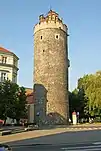

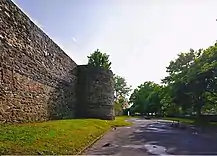
.jpg.webp)
